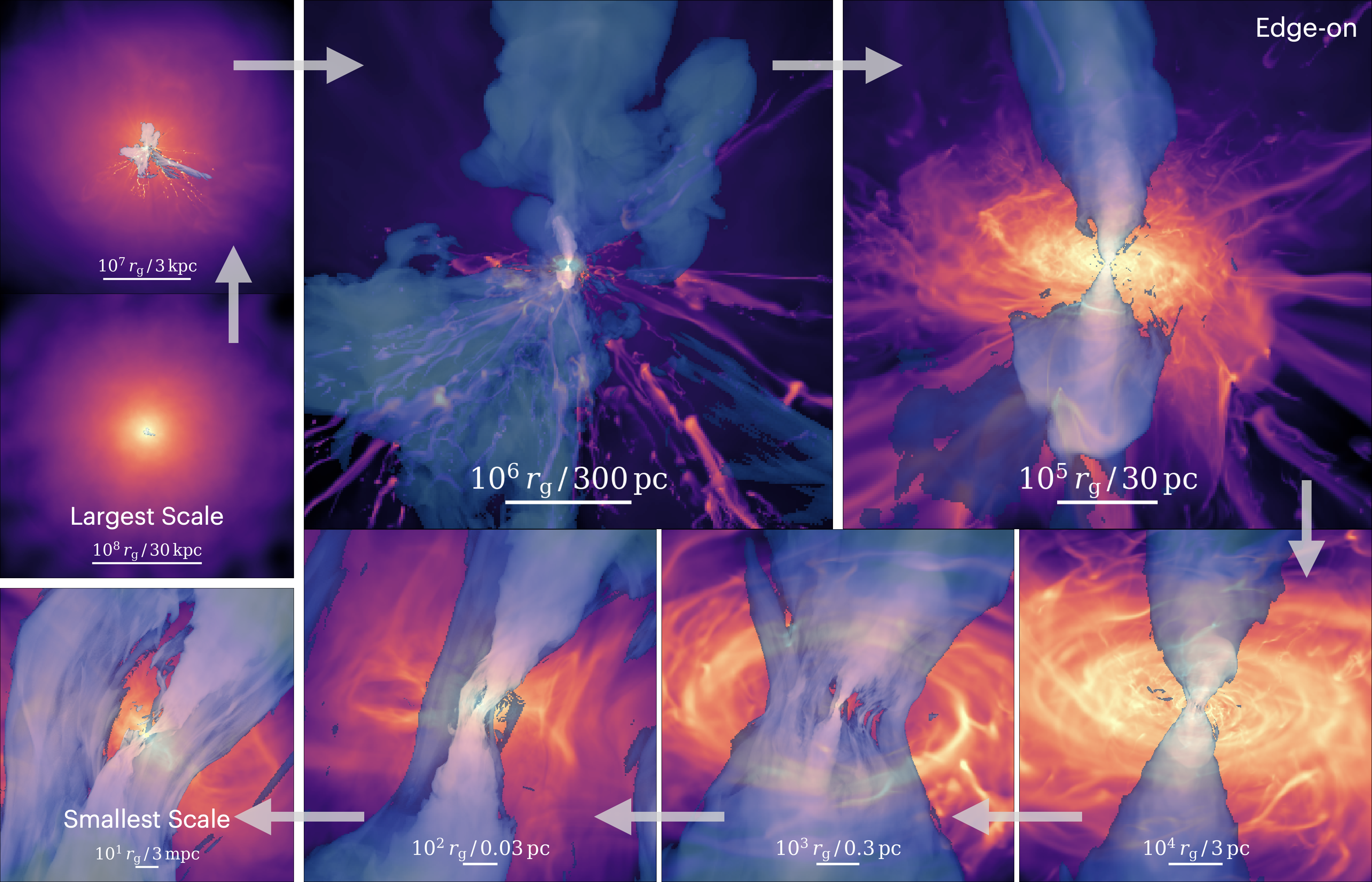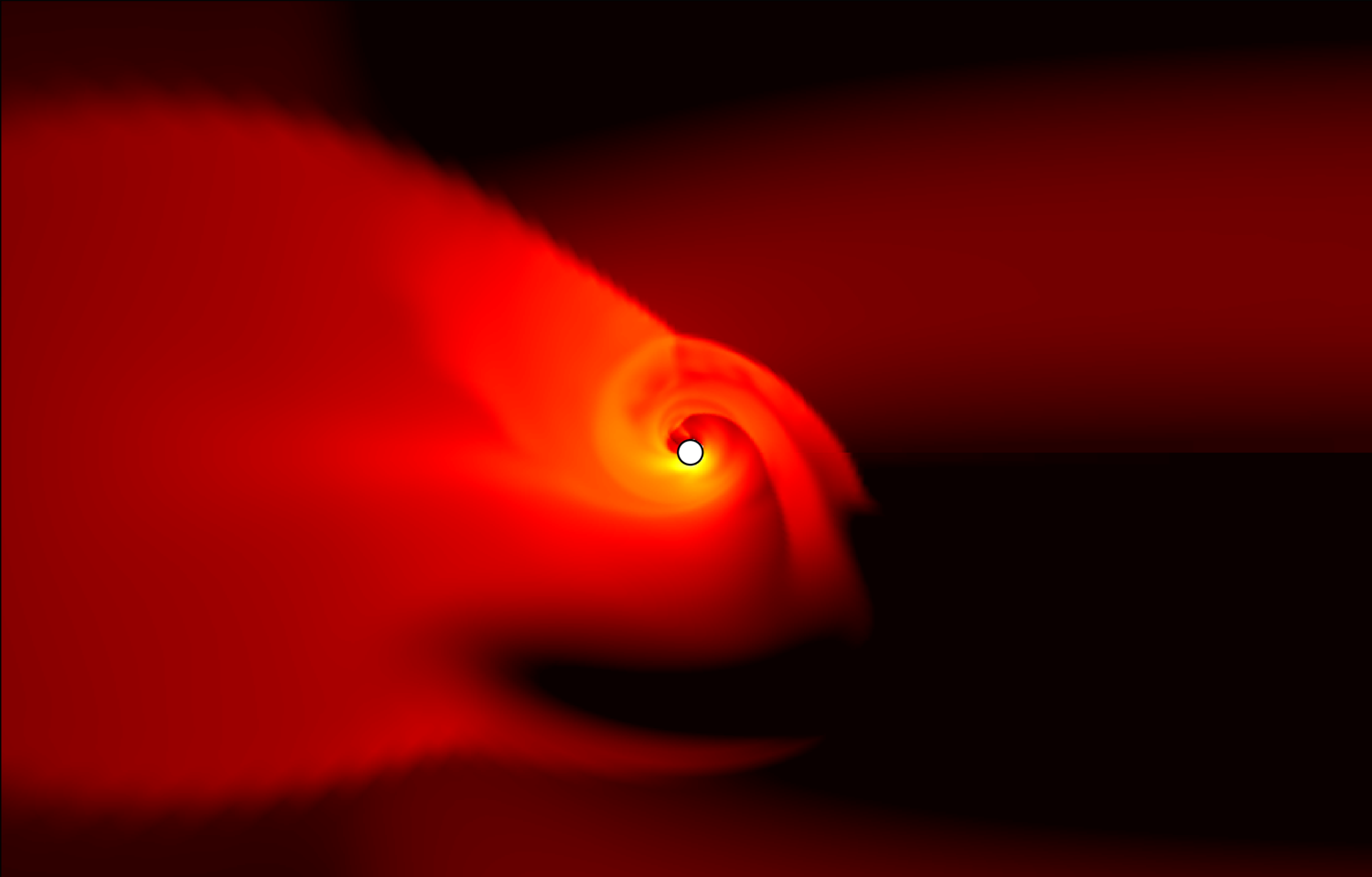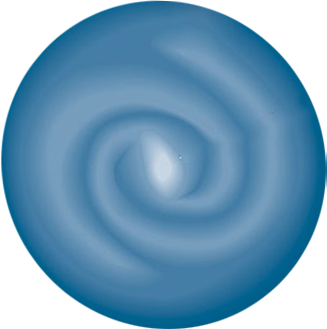Research
I am interested in both theoretical and observational astrophysics.
Cyclic Zoom: Multi-scale GRMHD Modeling of Black Hole Accretion and Feedback
arXiv:2504.16802 [astro-ph.HE]
We present a ``cyclic zoom’’ method to capture the dynamics of accretion flows onto black holes across a vast range of spatial and temporal scales in general relativistic magnetohydrodynamic (GRMHD) simulations. In this method, we cyclically zoom out (derefine) and zoom in (refine) the simulation domain while using a central mask region containing a careful treatment of the coarsened fluid variables to preserve the small-scale physics, particularly the magnetic field dynamics. The method can accelerate GRMHD simulations by $\gtrsim 10^5$ times for problems with large scale separation. We demonstrate the validity of the technique using a series of tests, including spherically symmetric Bondi accretion, the Blandford-Znajek monopole, magnetized turbulent Bondi accretion, accretion of a magnetized rotating torus, and the long-term evolution of an accreting torus about both Schwarzschild and Kerr black holes. As applications, we simulate Bondi and rotating torus accretion onto black holes from galactic scales, covering an extremely large dynamic range. In Bondi accretion, the accretion rate is suppressed relative to the Bondi rate by $\sim(10r_\mathrm{g}/r_\mathrm{B})^{1/2}$ with a feedback power of $\sim 0.01 \dot{M} c^2$ for vanishing spin, and $\sim 0.1 \dot{M} c^2$ for spin $a\approx0.9$. In the long-term evolution of a rotating torus, the accretion rate decreases with time as $\dot{M}\propto t^{-2}$ on timescales much longer than the viscous timescale, demonstrating that our method can capture not only quasi-steady problems but also secular evolution. Our new method likewise holds significant promise for applications to many other problems that need to cover vast spatial and temporal scales.
Magnetized Accretion onto and Feedback from Supermassive Black Holes in Elliptical Galaxies
arXiv:2405.11711 [astro-ph.HE]

We present three-dimensional magnetohydrodynamic (MHD) simulations of the fueling of supermassive black holes in elliptical galaxies from a turbulent cooling medium on galactic scales, taking M87* as a typical case. We find that the mass accretion rate is increased by a factor of $\sim 10$ compared with analogous hydrodynamic simulations. The scaling of $\dot{M} \sim r^{1/2}$ roughly holds from $\sim 10\,\mathrm{pc}$ to $\sim 10^{-3}\,\mathrm{pc}$ ($\sim 10\, r_\mathrm{g}$) with the accretion rate through the event horizon being $\sim 10^{-2}\, M_\odot\,\mathrm{yr^{-1}}$. The accretion flow on scales $\sim 0.03-3\,\mathrm{kpc}$ takes the form of magnetized filaments. Within $\sim 30\,\mathrm{pc}$, the cold gas circularizes, forming a highly magnetized ($\beta\sim 10^{-3}$) thick disk supported by a primarily toroidal magnetic field. The cold disk is truncated and transitions to a turbulent hot accretion flow at $\sim0.3\,\mathrm{pc}$ ($10^3\,r_\mathrm{g}$). There are strong outflows towards the poles driven by the magnetic field. The outflow energy flux increases with smaller accretor size, reaching $\sim 3\times10^{43}\,\mathrm{erg\,s^{-1}}$ for $r_\mathrm{in}=8\,r_\mathrm{g}$; this corresponds to a nearly constant energy feedback efficiency of $\eta\sim0.05-0.1$ independent of accretor size. The feedback energy is enough to balance the total cooling of the M87/Virgo hot halo out to $\sim 50$ kpc. The accreted magnetic flux at small radii is similar to that in magnetically arrested disk models, consistent with the formation of a powerful jet on horizon scales in M87. Our results motivate a subgrid model for accretion in lower-resolution simulations in which the hot gas accretion rate is suppressed relative to the Bondi rate by $\sim (10r_\mathrm{g}/r_\mathrm{B})^{1/2}$.
Toward Horizon-scale Accretion onto Supermassive Black Holes in Elliptical Galaxies
arXiv:2211.05131 [astro-ph.HE]
We present high-resolution, three-dimensional hydrodynamic simulations of the fueling of supermassive black holes in elliptical galaxies from a turbulent medium on galactic scales, taking M87* as a typical case. The simulations use a new GPU-accelerated version of the Athena++ AMR code, and span more than 6 orders of magnitude in radius, reaching scales similar to the black hole horizon. The key physical ingredients are radiative cooling and a phenomenological heating model. We find that the accretion flow takes the form of multiphase gas at radii less than about a kpc. The cold gas accretion includes two dynamically distinct stages: the typical disk stage in which the cold gas resides in a rotationally supported disk and relatively rare chaotic stages (\(\lesssim 10\%\) of the time) in which the cold gas inflows via chaotic streams. Though cold gas accretion dominates the time-averaged accretion rate at intermediate radii, accretion at the smallest radii is dominated by hot virialized gas at most times. The accretion rate scales with radius as \(\dot{M}\propto r^{1/2}\) when hot gas dominates and we obtain \(\dot{M}\simeq 10^{-4}-10^{-3}\rm\,M_\odot\,yr^{-1}\) near the event horizon, similar to what is inferred from EHT observations. The orientation of the cold gas disk can differ significantly on different spatial scales. We propose a subgrid model for accretion in lower-resolution simulations in which the hot gas accretion rate is suppressed relative to the Bondi rate by \((\sim r_{\rm g}/r_{\rm Bondi})^{1/2}\). Our results can also provide more realistic initial conditions for simulations of black hole accretion at the event horizon scale.
Hunting for Wandering Black Hole
Advisors: Kohei Inayoshi Luis C. Ho

In the Λ-cold dark matter universe, frequent galaxy mergers and the subsequent central BH interactions would probably create a population of wandering BHs. We investigated low-density accretion flows onto massive black holes orbiting around in the outskirts of their host galaxies (e.g., massive ellipticals, Milky Way, dwarf galaxies), performing three-dimensional simulations and semi-analytical calculations. We constructed radiative inefficient accretion-flow models for accretion near the horizon of a black hole. I applied the simulation results to the emission model and calculated the spectral energy distribution for the accretion flow onto a wandering black hole. I studied the detectability of wandering (super-massive) black holes in different types of galaxies, predicting that ALMA will enable us to hunt for a population of wandering BHs. I published a paper in the Astrophysical Journal as the first-author.
A New Channel of BulgeFormation via the Destruction of Short Bars
Advisors: Luis C. Ho, Victor P. Debattista
I studied real and simulated galaxies from both observational and dynamical points of view. Through morphological decomposition for the structures of the galaxy models in N-body simulations using IRAF and GALFIT, I investigated the long-term evolution of barred galaxies with growth of central BHs. After adjusting the models and performing a comprehensive analysis for about one year, we demonstrated that the destruction of short bar contributes significantly to the growth of the bulge which finally bears many similarities to a classical bulge in terms of observation. These results have important implications for the secular evolution of active galaxies and the effect of BH growth in shaping the inner structures of galaxies. This led to a first-author paper published in Astrophysical Journal.
Numerical Study of Modified Gravity Theory and the Application to Neutron Stars and Gravitational Waves
Advisor: Lijing Shao
I investigated a scalar-tensor gravity theory proposed by Damour and Esposito-Farèse (DEF) that predicts large deviations from General Relativity for neutron stars through spontaneous scalarization phenomena. I constructed reduced-order surrogate model for the derived quantities in this theory, coded in a python package pySTGROMX that speeds up calculations at two orders of magnitude yet still keeps accuracy, compared with the previous algorithms. As an application, we utilized pySTGROMX to explore constraints on the DEF theory with latest well-timed binary pulsars and gravitational waves through Markov Chain Monte Carlo simulations. The work is summarized in a first-author paper published in the Physical Review D.
